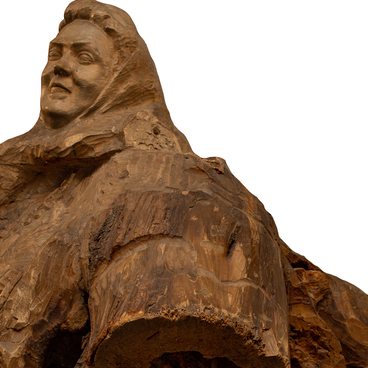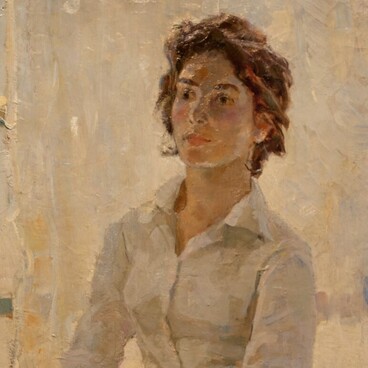The statue ‘There Is No Land Beyond the Volga’ was created by sculptor Vladimir Druzin whose numerous works were dedicated to the heroic acts of Russian soldiers. The composition depicts a climactic scene of a soldier rushing into a fight with his last strength, doing his best not to break down under the enemy’s attack. The statue is not a portrait of a specific person, but a generalized image of a courageous Soviet soldier — the strong physique and the dynamic pose demonstrate the man’s determination while the serious, concentrated look on his face shows his commitment to do whatever it takes.
In this work, the artist elaborated on the subject of his other statue dedicated to the Battle of Stalingrad. It was titled ‘The Enemy Shall Not Pass’ and became his final project at the Surikov Art Institute in Moscow.
For the statue ‘There Is No Land Beyond the Volga’ Druzin used bronze casting. In order to create a sculpture, an artist first creates an original model. Most often it is made of wax, clay or plaster (and nowadays also plasticine). This is the most important stage because the model must be exactly the same as the future statue down to every last detail. After that, a special mold is shaped for the model which is then used to cast the sculpture in bronze in several stages. The preparation may take many hours or even days while the molten metal solidifies in only several minutes.
War heroes were an important theme of mid-20th century sculpture. In their work artists turned to the recent tragic events of the Great Patriotic War of 1941–1945. By portraying these images in many of their works Soviet artists preserved the memory of the war.
Vladimir Druzin dedicated himself to this work. In 1962, together with sculptor Pyotr Sazhin and architect Gennady Belyankin he created one of the favorite monuments of Yekaterinburg citizens — the monument to the Ural Volunteer Tank Corps located on the Railway Station Square. The citizens often arrange to meet ‘under the mitten’ referring to the outstretched arm in a mitten of one of the characters.
Druzin’s legacy includes other significant works dedicated to the war: a monument to the students, teachers and employees of the Ural Polytechnic Institute who died in battle, “A Soldier with a Rifle near a Plough”, “A Blacksmith Soldier”, “A Discharged Soldier Back in the Field”.
In this work, the artist elaborated on the subject of his other statue dedicated to the Battle of Stalingrad. It was titled ‘The Enemy Shall Not Pass’ and became his final project at the Surikov Art Institute in Moscow.
For the statue ‘There Is No Land Beyond the Volga’ Druzin used bronze casting. In order to create a sculpture, an artist first creates an original model. Most often it is made of wax, clay or plaster (and nowadays also plasticine). This is the most important stage because the model must be exactly the same as the future statue down to every last detail. After that, a special mold is shaped for the model which is then used to cast the sculpture in bronze in several stages. The preparation may take many hours or even days while the molten metal solidifies in only several minutes.
War heroes were an important theme of mid-20th century sculpture. In their work artists turned to the recent tragic events of the Great Patriotic War of 1941–1945. By portraying these images in many of their works Soviet artists preserved the memory of the war.
Vladimir Druzin dedicated himself to this work. In 1962, together with sculptor Pyotr Sazhin and architect Gennady Belyankin he created one of the favorite monuments of Yekaterinburg citizens — the monument to the Ural Volunteer Tank Corps located on the Railway Station Square. The citizens often arrange to meet ‘under the mitten’ referring to the outstretched arm in a mitten of one of the characters.
Druzin’s legacy includes other significant works dedicated to the war: a monument to the students, teachers and employees of the Ural Polytechnic Institute who died in battle, “A Soldier with a Rifle near a Plough”, “A Blacksmith Soldier”, “A Discharged Soldier Back in the Field”.



